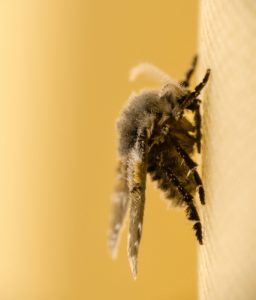Small Flies
By Chris Williams on March 30, 2012.
Q. I have small, dark colored flies. Recently great numbers of these flies are showing up in my cellar, where we have a guest room and bath. Nothing has changed, and we rarely even use this part of our house. What are these flies and what can I do to stop them?
A. Three types of flies come to mind in cases like this. The Drain Fly, the Phorid Fly, and the Fungus Gnat are the most likely suspects. All of three of these flies share similar breeding sites, and can become quite numerous in some situations. The common denominator is organic material.
 These flies prefer to breed in moist, dark locations with plenty of rotting organic material. Drains, septic systems, sump-pumps, lifting pumps, holding tanks, leach fields, and poorly drained soil may all contain the right stuff! Inside the home places like flower boxes, fountains, potted plants, and water leaks may also provide adequate moisture and organic substrate.
These flies prefer to breed in moist, dark locations with plenty of rotting organic material. Drains, septic systems, sump-pumps, lifting pumps, holding tanks, leach fields, and poorly drained soil may all contain the right stuff! Inside the home places like flower boxes, fountains, potted plants, and water leaks may also provide adequate moisture and organic substrate.
I have found Fungus Gnats in old bulbs left in a closet, a rotting Jade plant, a rotting cactus, old onions, and most commonly over watered house plants like palms or other large, hard to move installations. Water and debris build up in the outer liner and never dry out, causing large numbers of little gnats.
Phorid, or Humpbacked Flies also need moisture and organic matter, but their breeding sited is somewhat different, at least in the home. Rotting vegetation, particularly near a house will provide sufficient material for robust populations outside. The adults, who are strongly attracted to lights, may enter from outside and be quite bothersome in some areas.
Inside the home phorid flies may find suitable material for breeding within damp, moldy wall voids, but more commonly in holding or lifting tank rarely used. Slime films build up in stagnant water and this is exactly the substrate phorid flies prefer. In some cases populations can develop in septic systems, and enter the house through dry or rarely used pipelines or live in the pipelines themselves, if the angle is wrong and standing water develops. Most of the cases I have come across regarding phorid flies involved an under used lifting pump, from either a basement bathroom, or de-humidification system.
Drain Flies, or Moth flies also reside in yucky places like drains, sewers, and septic systems. This common fly is small, flies poorly, and resembles a tiny heart shaped moth. Most species are dark in color. One or two drain flies are common as they prefer the scum found in drains and similar locations with slow, occasional water movement.
Most plumbing is designed to vent above the roofline, and is sealed by a series of “s” joints. These turns allow water to pool on the entrance side of the pipe, and drain below to the main outflow, which leads to the sewer system, a holding tank, or leach field. In some cases long distances are involved, cracks may develop, or other factors come into play which allows organic material to build up within the system. Large populations of drain flies can develop in these locations. Usually the outflow is separated from the interior living space. Sometimes, for instance, if a basement toilet or sink drain is not used for an extended time, the water in the “s” pipes can evaporate, leaving the living space open to the outflow pipe. Once he drain is open, any adult flies living there are able to fly out into the adjacent area. Large numbers of drain flies may indicate an open drain system, or even worse a sewer leak within the structure.
I think the first step in this situation is to get a positive identification of the fly species involved, and possibly an inspection of plumbing to determine if there are any issues there. A licensed Pest Control Technician will be able to I.D. the fly at large, and make specific recommendations. Several treatments can be safely made to minimize or eliminate fly infestations, along with appropriate plumbing fixes.